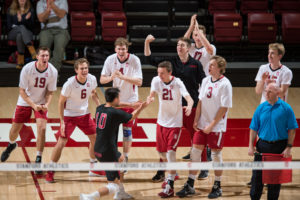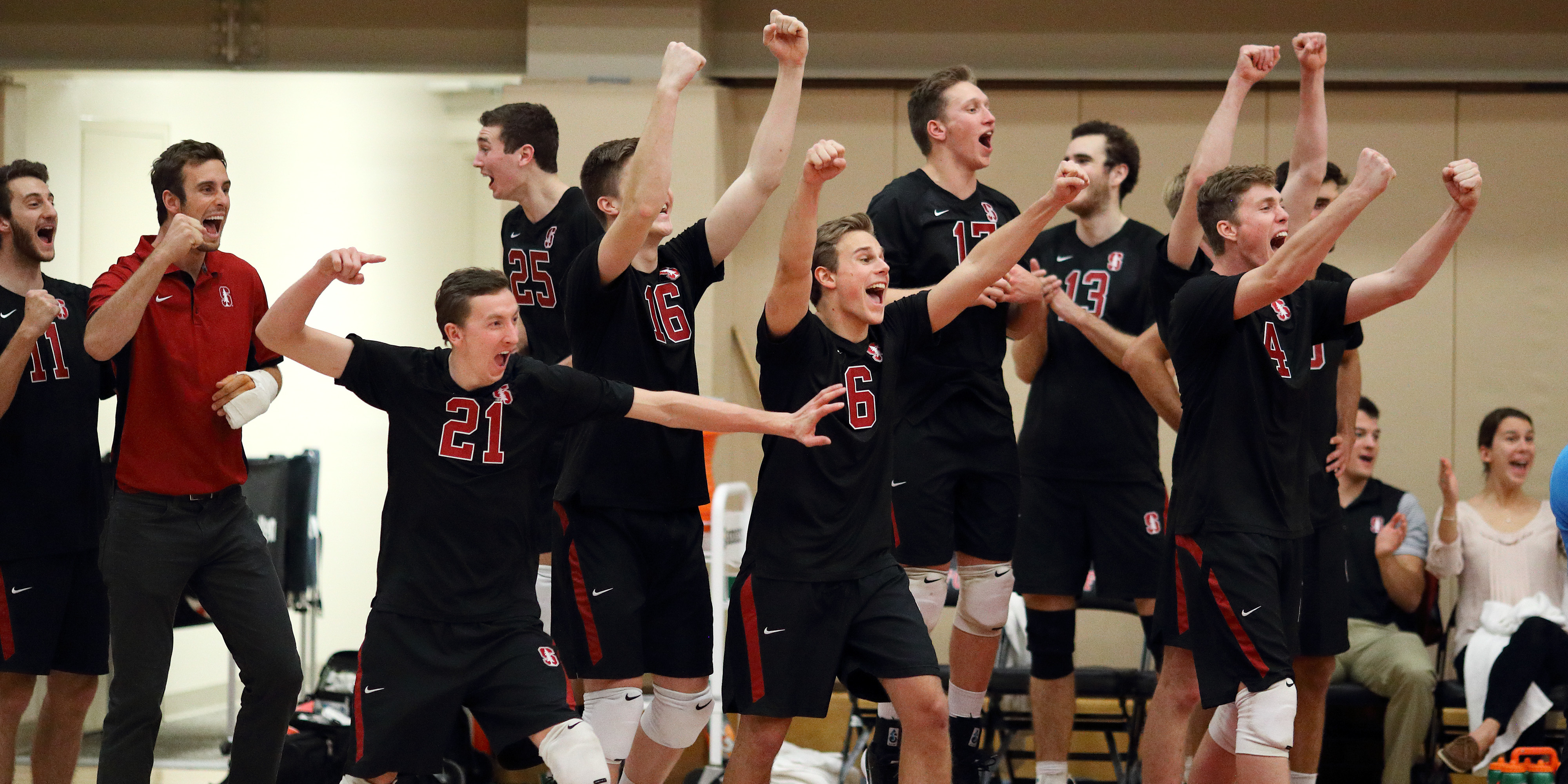It’s a tied match, headed into a decisive fifth set against UC San Diego, and the Stanford bench is going crazy.
The yelling and screaming continue as the Cardinal take an early lead, continuing point after point. A kill by senior outside hitter Colin McCall brings Stanford to match point, with the team leading 14-10. UCSD fights back with a kill of its own, before finally, a Triton makes a service error and the comeback is complete.
Bedlam.
The bench rushes the court to celebrate clinching a conference playoff spot in the team’s final regular season match at Maples Pavilion. With the win, Stanford had completed a turnaround to stay undefeated in five-set matches, improving to 4-0 for the season.
One of Stanford’s hallmarks this season has been its ability to come back to win close games, fighting and winning five-set matches time and time again. In a sport that requires focus and energy on each point, especially late in matches, Stanford is known for hanging on and delivering in the most crucial moments. If you ask junior setter Kyle Dagostino, this special energy comes from the bench.

This season is not an anomaly. The Stanford men’s volleyball bench has developed a life and culture of its own, with its history being passed down from season to season.
“It started with Jake Kneller [‘13] back in the day,” recalls head coach John Kosty. “Jake started this concept of ‘bennergy,’ where the bench can give as much energy to the court as the guys on the court can give to what they’re doing.”
“Bennergy,” or bench energy, is evident to anyone who watches the team play. Cheering is loud, celebrations are exuberant and the enthusiasm is seemingly endless.
The running onto the court often comes much to the chagrin of referees, who work to keep the Cardinal bench in control. Although the bench has received warnings in the past, Kosty seems to find those warnings worthwhile:
“I love it when down-refs warn our bench to stay back, stay off the court, stop running across the court. When we were down at Irvine, we were warned three or four times to stay back and stop running all the way across the back of the court. I love that because it means that our whole team is engaged, and we’re playing as one.”
The history of “bennergy” as it stands for the current Stanford team might have started last year, in an early season matchup against the BYU Cougars. BYU is known for producing competitive teams every season and is also known for a devoted crowd of fans. The two teams have developed somewhat of a rivalry over the past few seasons, playing to packed crowds in each matchup. BYU leads the overall series history 33-21 and has defeated the Cardinal in the last three regular season contests, but Stanford is the last team to win in a postseason matchup.
“The fans are right on your back, and they’re twiddling their fingers right in your face as you’re back to serve and barking down your ear,” said Dagostino. “When we went to BYU that first weekend of MPSF play, we went crazy because we knew that we had to compete with the crowd of four or five thousand BYU fans.”
That match, played on January 15, 2016, was yet another five-set comeback win for the Cardinal. The then-No. 11 team had gone down two-sets-to-one against then-No. 1 BYU before rallying to win the fourth set and fighting again to win the fifth by a score of 15-11. The upset was BYU’s first loss of the 2016 season and set the tone for the Cardinal going forward.
“It sort of became our MO for the season to go out and have these series of celebrations that we were going to do at any given time and organize them in a way that we could excite our team with specific plays,” said Dagostino.
With the energy high, Stanford played to a 19-6 record for the season, tying for second in the MPSF while leading the nation with three AVCA first-team All-Americans.
Having experienced the success of “bennergy” in 2016, the team approached the 2017 season with intentionality, setting the standard for bench participation early on. And yet with a new roster, the bench found itself developing a somewhat different dynamic.
“We’ve moved away from specific cheers and it’s become more about paying attention and being a little more tuned to what our team needs at the time,” noted Dagostino.
What does that look like?
“[Freshman] Eli Wopat does a fantastic job of just getting hyped every play and every big point,” noted Dagostino. “When you go back and watch film, Eli is running around the court in the back lines, he’s flexing his muscles through the net, he’s doing everything he can to have fun and show our team on the court that he’s enjoying himself. Before Colin McCall was put into the starting lineup, we would do this celebration where any time the other team served the ball out or hit the ball out, I would stand in front of him, and he would put his arms underneath my armpits and lift me up, and I would just wave to the crowd and the other team.”
Dagostino serves as an example of a crossover. Although the junior has made an appearance in every match this season, he has only started in six of 25 matches, coming off the bench to provide a strong service game and defensive game. As one of the ringleaders on the bench, he has learned to balance a complex role.
“I’m not quite as celebratory as some of the other guys [on the bench], but I like to feed information,” he said. “If you see me in matches, you’ll often see me turning to the bench and saying ‘Great job, keep this energy going’ or ‘We need more.’ But when you’re on the bench, you have a narrower scope of focus. You’re doing everything with your body and your voice to try to excite those around you.”
Dagostino is one of many players that have found success coming off the bench this season. Injuries have caused players to step into new roles both throughout the year and in long matches. Kosty, known for utilizing his full lineup, will often turn to the bench to provide energy on the court as well, something that he doesn’t hesitate to do with the game on the line.
“They’re in tune and ready and still warm and hyped up,” said Kosty. “Those guys come on and give us either a shot in the arm or that one extra point to put us over the top in those tight matches.”
As the season has progressed, the “bennergy” has only increased. Heading into this weekend’s MPSF quarterfinal matchup against BYU, the team knows that the bench will be a huge factor as Stanford again competes with not only the Cougars, but a large crowd.
“We talk about bennergy a lot, and I think it’s grown and has a life of its own now, especially in playoffs,” Kosty remarked. “To compete against five thousand people at BYU with only about 45 of them cheering for Stanford, you can feel that energy coming from our sideline.”
That Stanford will face BYU this Saturday seems only fitting, as the 2016 comeback in Provo, Utah sparked the “bennergy” legacy of this group of players. The Cardinal hope to replicate that upset again, something that will take a full team effort, including increased energy from the bench.
The full-circle nature of this matchup was not missed on Dagostino: “I’m excited for our team to go back to BYU this weekend because that was sort of the inception of what I came to know as bennergy last season. I’m excited to see how it’s going to be different and how we’re going to match up with the crowd. I know that we won’t disappoint, I know that for a fact.”
No. 9 Stanford will take on No. 3 BYU in the MPSF quarterfinals on Saturday at 6 p.m. in Provo, Utah.
Contact Laura Anderson at lauraand ‘at’ stanford.edu.
